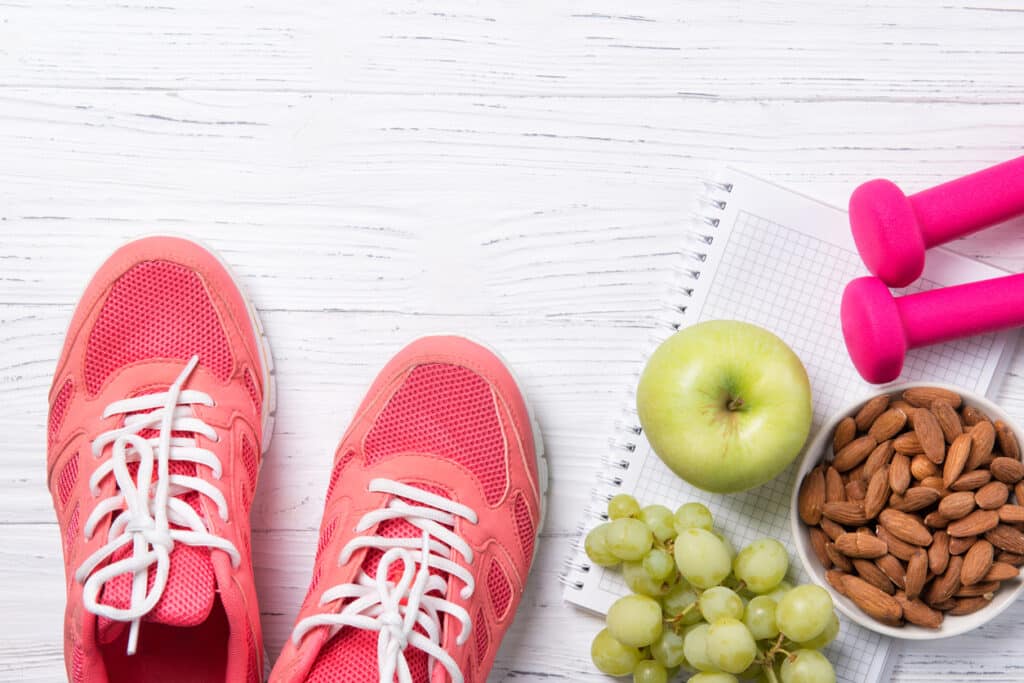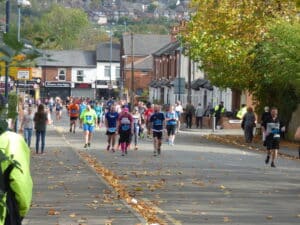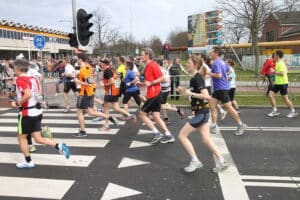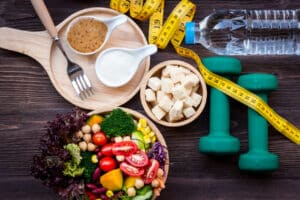If you’re training for a half marathon, what you are or aren’t eating can be just as important as your training, if not more so. If you aren’t fuelling your body properly, your performance will be adversely affected. It is important to eat a proper, healthy diet when training for any race, but especially something as taxing on your body as running 21.1 kilometers.
A balanced half marathon diet starts long before race day. You can’t just show up on the start line and expect your body to perform at its maximum if you haven’t been fueling it with the proper nutrition during training and leading up to the start of your race. Yes, there are exceptions; we all know that one person that can eat Mcdonald’s 3 times a day and still crush every workout and race.
For the rest of us though, what we put in our bodies is incredibly important. This is especially true when you are trying to get the absolute best performance out of your body. Hitting your half marathon goal time can be a lot more difficult if you fuel your body poorly.
Where to start
Your body can burn protein, carbohydrates, and fat as fuel. When running a race such as a half marathon, your body is mostly running in an aerobic state and burning mostly glucose. Your body turns carbohydrates into glycogen, which it stores in your liver and muscles. When your body needs more glucose, it breaks the glycogen down into glucose and it is transferred to the muscles where it is used as energy.
The aim is to eat at least 50% of your calories from carbohydrates, but up to 70% can be even more beneficial. Carbohydrates are the easiest form of fuel for your body to break down and use for energy.
Increasing your carb intake during a half marathon training cycle will ensure that every training run is started with full energy reserves, giving you the best chance of a successful training cycle.
For this reason, it is very important to keep a healthy diet during your training period, especially leading up to race day. If your glycogen stores aren’t filled before you set off, you are likely to “hit the wall” a lot sooner than you should.
There is no worse way to ruin a training cycle than to bonk and then “Did Not Finish” (DNF) simply because you weren’t properly fueled for your race. This is one reason why a half marathon taper is such an important part of a successful race plan.
Simple Carbs
Simple carbohydrates are sugars. While some of them do occur naturally in some foods, most are added to a lot of the foods we all eat. Some examples of simple carbs that are added to a lot of foods are raw sugar, corn syrup, glucose, fructose, and sucrose. If you look at the label of pretty much any “unhealthy” food, you’ll probably find at least one of these on the ingredients list, if not more.
Complex Carbs
Complex carbohydrates are higher in nutrients than simple carbs are. They are also higher in fiber and digest slower. This makes them a good option for weight control as well, as they make you feel full for longer.
Starch and fiber are the two types of complex carbs. The more of these you can fit into your diet, the better. Some foods have both, and some have one or the other. A few examples of foods high in dietary fiber are fruits, vegetables, nuts, beans, and whole grains. Some examples of foods that are considered to be more starchy than fibrous are whole wheat bread, cereal, oats, corn, and rice.
The following are the complex carbs that should be included in a healthy diet:
Whole grains – A great source of fiber as well as potassium and magnesium. Choose whole-grain over white options whenever possible (pasta, bread, etc) as they are less processed, giving them more healthy nutrients
Fruits rich in fiber – Bananas, apples, and berries are high in fiber
Vegetables rich in fiber – Asparagus, cabbage, broccoli, and leafy greens are just a few examples of fiber-rich vegetables
Beans – Not only are beans filled with fiber, but also potassium, folate, and iron too
The average adult needs to add about 200-300 calories extra for every hour of exercise during a half marathon training cycle. (Example – After a 3-hour training run, the average adult would need to add an additional 600-900 calories to their diet for that day, on top of what they normally eat). The more of these that come from complex carbs, the better.
Proteins
Proteins are very important for helping your body recover after a workout. Eating protein after a workout also promotes muscle growth. The important thing to remember is that your muscles are being rebuilt with the foods that you ingest, so the healthier the proteins are, the better. Lean proteins are best, such as chicken (white meat), fish, eggs, and lean pork.
Vegetarians can source all of their protein needs from beans, lentils, tofu, etc. There are lots of great, healthy choices no matter what your dietary restrictions are. The important thing to remember is to try to have some protein within 30-60 minutes of finishing a workout, as this helps your muscles rebuild as efficiently as possible.
Energy Gels and Sports Drinks
Another thing to think about adding to your diet during half marathon training is energy gels and sports drinks. Both are great sources of calories that give you a quick shot of energy. Since they are usually high in sugar, your body is able to convert them into energy quickly and easily.
Both can be consumed during longer runs to help keep your glycogen stores topped up. Generally, once runs start to get over an hour in length, you’ll want to start carrying some form of calories to consume.
Energy gels come in all different forms and flavors. Some are gels, some are chewable gummies, and others are added to water. No matter what kind you choose, they are all created to give your body calories and other essential nutrients, depending on the brand.
Energy drinks such as Gatorade or Powerade are also great sources of electrolytes. As you’re sweating during a run, you are sweating out salt. Sports drinks are usually high in sodium to help you replenish your electrolytes, either during or after a run or workout.
The most important thing to remember is to try anything that you plan on using on race day during training runs. Learning what works for fueling your body during runs is a very important part of training.
Once you find something that works, find a backup plan too. Sometimes on race day, your body won’t agree with what you’re trying to fuel it with. Having a “Plan B” is crucial for succeeding if that does happen. If you run enough races, this will eventually happen to you. Having a backup plan can save your race if things do go wrong.
The last step involving nutrition before race day is “carb loading.” This is usually done over the last 2-3 days before your half marathon, during the last days of your taper. By increasing your carbohydrate intake, you are ensuring your body’s glycogen stores are completely topped up before race day.
This is an incredibly important step in having a successful race. If your glycogen isn’t completely topped up, you’re essentially starting the race with a fuel tank that isn’t full.
Hydration
Hydration is an often overlooked aspect of a proper half marathon diet plan. If your body isn’t getting enough water, you won’t perform at your best, plain and simple. Our bodies are made up of 60% water, so keeping properly hydrated can be as important, if not more, than what you eat.
It is recommended that the average adult drink approximately 30 ml per kilogram of body weight, per day. This is before taking into account how much you lose from sweating during exercise.
For every hour of exercise, you should be trying to take in roughly 400-800ml per hour. For any training run longer than 30 or 40 minutes, carrying some water or stopping along the way is recommended.
On race day you’ll usually have aid stations set up with water, but during training runs, it is important to bring your own. There are many different ways to carry water, and every person prefers a different method for a different reason. Trying them all out and seeing what you prefer is the best way.
Some examples are hydration packs, belts with bottles, handheld bottles, and more. If you are running loops you can also set up your own little aid station so you can grab water (and snacks!) every time you go by it.
Frequently Asked Questions
Whole-grain breads, pastas, and cereals. Legumes such as lentils, chickpeas, and kidney beans. Starchy vegetables such as sweet potatoes, potatoes, and corn.
While some simple carbs are naturally occurring in foods (Fruits, milk and milk products), most are found in processed and refined foods. Candies, chocolate, pop, most baked goods, and most cereals are usually filled with simple carbs.
The more processed and refined a food is, the more you’ll want to avoid it. Your body gets little to no benefit from eating them, and they should be swapped out for more complex carbs whenever possible. It is important to treat yourself from time to time, especially during a tough training cycle, but the fewer simple carbs in your diet the better.
You’ll want your race day breakfast to be a combination of carbs and protein, such as a bagel with peanut butter, and a banana. It is important not to overeat before a race, you don’t want to try to eat a whole meal.
Whatever you plan to eat on the morning of your race, make sure you have tried it before at least one or two runs beforehand. Even still, the nervousness of a race day can make your stomach not want to digest things you can normally eat, so keep a backup plan in mind just in case.
Gels and gummies are two of the easiest things to digest. Sports bars are a source of both carbs and protein but are generally a little harder to digest while running than gels or sports drinks.
“Real food” such as chips, pretzels, candy, and dried fruits are all fairly easy to eat and digest while running. Try a lot of different things during training to figure out what works best for your body. Sometimes you’ll need to slow down a bit to digest, so having a pacing chart can keep you on pace even if you have to slow down once or twice to digest.
An easily digested meal of complex carbs should be eaten roughly 2 to 4 hours before a run. This gives time for your body to turn the carbs into glycogen. If you haven’t got time to eat that long before a run (Example – early morning run) something simple like a banana or a handful of trail mix can often be enough.
Conclusion
It is important to remember that every single person is different. Don’t be discouraged if you don’t react well to what works for other people when changing your diet. Some people are lucky and their bodies seem to react well to everything, and other people need to be very careful with their diet.
When it comes to eating during runs, make sure that whatever you are going to eat on race day, you’ve tried it previously during a training run or two. Every person’s stomach reacts differently to the stress of a half marathon, and a race is a terrible time to find out that you can’t digest the foods at the aid stations. By practicing eating different real foods, gels, and energy bars during training runs, you’ll know exactly what works best for your body on race day.
Most importantly, watch for improvements in your running once you’ve cleaned up your diet a little bit. You might start to notice you aren’t as sore after a run, or that you recover quicker after interval workouts. Once you start fueling your body with healthier choices, your half marathon training should be even more successful.
RELATED ARTICLES














